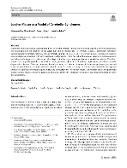| dc.contributor.author | Roy Choudhury, Nilpawan | |
| dc.contributor.author | Hilber, Pascal | |
| dc.contributor.author | Cendelín, Jan | |
| dc.date.accessioned | 2025-03-21T09:41:08Z | |
| dc.date.available | 2025-03-21T09:41:08Z | |
| dc.date.issued | 2025 | |
| dc.identifier.uri | https://hdl.handle.net/20.500.14178/3039 | |
| dc.description.abstract | Cerebellar extinction lesions can manifest themselves with cerebellar motor and cerebellar cognitive affective syndromes. For investigation of the functions of the cerebellum and the pathogenesis of cerebellar diseases, particularly hereditary neurodegenerative cerebellar ataxias, various cerebellar mutant mice are used. The Lurcher mouse is a model of selective olivocerebellar degeneration with early onset and rapid progress. These mice show both motor deficits as well as cognitive and behavioral changes i.e., pathological phenotype in the functional domains affected in cerebellar patients. Therefore, Lurcher mice might be considered as a tool to investigate the mechanisms of functional impairments caused by cerebellar degenerative diseases. There are, however, limitations due to the particular features of the neurodegenerative process and a lack of possibilities to examine some processes in mice. The main advantage of Lurcher mice would be the expected absence of significant neuropathologies outside the olivocerebellar system that modify the complex behavioral phenotype in less selective models. However, detailed examinations and further thorough validation of the model are needed to verify this assumption. | en |
| dc.language.iso | en | |
| dc.relation.url | https://doi.org/10.1007/s12311-025-01810-5 | |
| dc.rights | Creative Commons Uveďte původ 4.0 International | cs |
| dc.rights | Creative Commons Attribution 4.0 International | en |
| dc.title | Lurcher Mouse as a Model of Cerebellar Syndromes | en |
| dcterms.accessRights | openAccess | |
| dcterms.license | https://creativecommons.org/licenses/by/4.0/legalcode | |
| dc.date.updated | 2025-03-21T09:41:08Z | |
| dc.subject.keyword | Ataxia | en |
| dc.subject.keyword | Cerebellum | en |
| dc.subject.keyword | Lurcher Mouse | en |
| dc.subject.keyword | Cerebellar Cognitive Affective Syndrome | en |
| dc.subject.keyword | Validity | en |
| dc.identifier.eissn | 1473-4230 | |
| dc.relation.fundingReference | info:eu-repo/grantAgreement/MSM//LX22NPO5107 | |
| dc.relation.fundingReference | info:eu-repo/grantAgreement/UK/COOP/COOP | |
| dc.relation.fundingReference | info:eu-repo/grantAgreement/MSM/EF/EF16_019/0000787 | |
| dc.relation.fundingReference | info:eu-repo/grantAgreement/UK/GAUK/GAUK49724 | |
| dc.date.embargoStartDate | 2025-03-21 | |
| dc.type.obd | 73 | |
| dc.type.version | info:eu-repo/semantics/publishedVersion | |
| dc.identifier.doi | 10.1007/s12311-025-01810-5 | |
| dc.identifier.utWos | 001434452700001 | |
| dc.identifier.eidScopus | 2-s2.0-85219599829 | |
| dc.identifier.obd | 663211 | |
| dc.identifier.pubmed | 40016581 | |
| dc.subject.rivPrimary | 30000::30100::30103 | |
| dc.subject.rivSecondary | 30000::30100::30105 | |
| dcterms.isPartOf.name | The Cerebellum | |
| dcterms.isPartOf.issn | 1473-4222 | |
| dcterms.isPartOf.journalYear | 2025 | |
| dcterms.isPartOf.journalVolume | 24 | |
| dcterms.isPartOf.journalIssue | 2 | |
| uk.faculty.primaryId | 111 | |
| uk.faculty.primaryName | Lékařská fakulta v Plzni | cs |
| uk.faculty.primaryName | Faculty of Medicine in Pilsen | en |
| uk.department.primaryId | 1360 | |
| uk.department.primaryName | Ústav patologické fyziologie | cs |
| uk.department.primaryName | Department of Pathological Physiology | en |
| uk.department.secondaryId | 100012968318 | |
| uk.department.secondaryName | Biomedicínské centrum | cs |
| uk.department.secondaryName | Biomedical Center | en |
| dc.type.obdHierarchyCs | ČLÁNEK V ČASOPISU::článek v časopisu::přehledový článek | cs |
| dc.type.obdHierarchyEn | JOURNAL ARTICLE::journal article::summarizing article | en |
| dc.type.obdHierarchyCode | 73::152::205 | en |
| uk.displayTitle | Lurcher Mouse as a Model of Cerebellar Syndromes | en |

